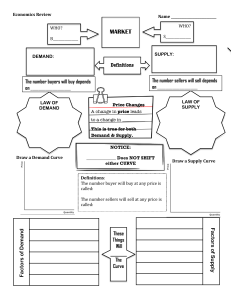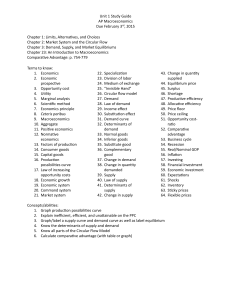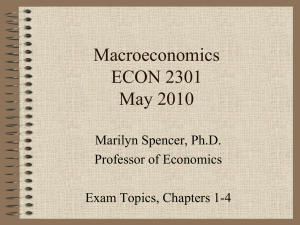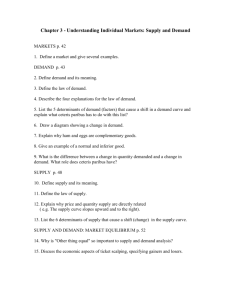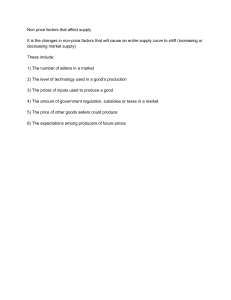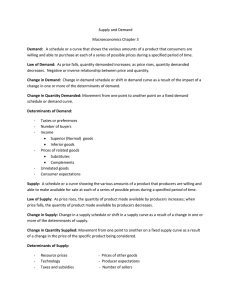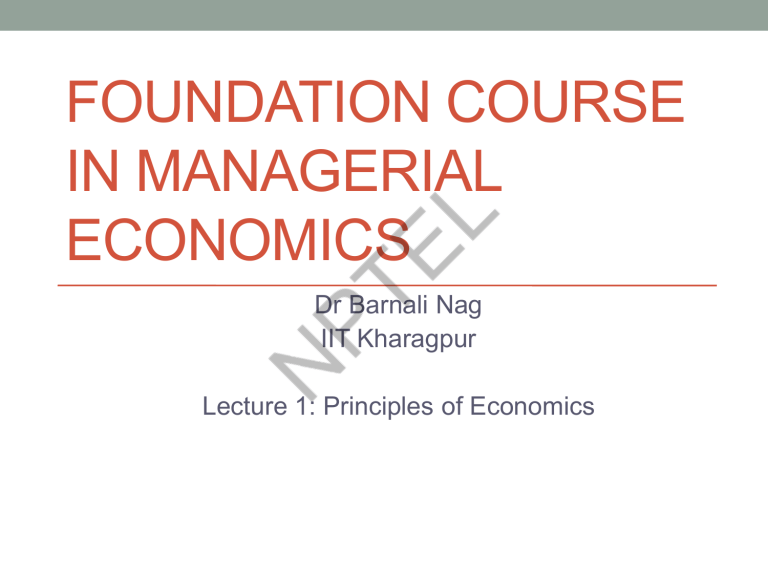
FOUNDATION COURSE IN MANAGERIAL ECONOMICS Dr Barnali Nag IIT Kharagpur Lecture 1: Principles of Economics What is economics all about? • Scarcity of resources • Trade off • And how people make choices Principles of how people make decisions • PRINCIPLE #1: People Face Tradeoffs • Efficiency vs Equality • PRINCIPLE #2: The Cost of Something Is What You Give Up to Get It • The opportunity cost of any item is whatever must be given up to obtain it • PRINCIPLE #3: Rational People Think at the Margin • PRINCIPLE #4: People Respond to Incentives Principles of how people interact • PRINCIPLE #5: Trade Can Make Everyone Better Off • PRINCIPLE #6: Markets Are Usually A Good Way to Organize Economic Activity • PRINCIPLE #7: Governments Can Sometimes Improve Market Outcomes • When markets fail – e.g. externalities, public goods, equity etc Principles of how the economy works as a whole • PRINCIPLE #8: A Country’s Standard of Living Depends on Its Ability to Produce Goods & Services • PRINCIPLE #9: Prices Rise When the Government Prints Too Much Money • PRINCIPLE #10: Society Faces a Short-run Tradeoff Between Inflation and Unemployment FOUNDATION COURSE IN MANAGERIAL ECONOMICS Dr Barnali Nag IIT Kharagpur Lecture 2: Introduction to Demand & Supply framework Demand & Supply • What is a competitive market? • What is demand curve and how is it determined? • What are the factors affecting demand? • What is supply curve and how is it determined? • What are the factors affecting supply? • What is market equilibrium and how is price determined in the market? Assumption • We assume a competitive market where • Many buyers and sellers • All goods are perfect substitutes • Buyers and sellers can easily enter or exit the market • Everyone is a price taker Demand • Quantity demanded of any good is the amount of that good that the consumers are willing to purchase at a certain price • Law of Demand: Other things remaining the same the quantity demanded of any good would fall when prices rise FOUNDATION COURSE IN MANAGERIAL ECONOMICS Dr Barnali Nag IIT Kharagpur Lecture 3: Price and non price determinants of demand Determinants of demand • Other things remaining same, demand curve is relationship between price and quantity of a particular good that the consumers are willing to buy. • These other things are the non-price determinants of demand, or, demand curve shifters Non price determinants of demand 1. Number of buyers 2. Income a. Normal good => Demand for normal good increases with income b. Inferior good => Demand for inferior good falls with rise in income 3. Prices of related goods a. Substitutes => Demand Increases with increase in price of substitute b. Complements => Demand increases with fall in price of substitutes 4. Tastes and preferences 5. Expectations Example • What happens to demand for ebooks in the following scenarios: • Price of e-reader falls • Price of e-books falls • Price of books fall FOUNDATION COURSE IN MANAGERIAL ECONOMICS Dr Barnali Nag IIT Kharagpur Lecture 4: Supply curve and its determinants Supply • Other things remaining same, supply curve is relationship between price and quantity of a particular good that the producers are willing to supply. • These other things are the non-price determinants of supply which shift the supply curve • Law of supply: Other things remaining same the quantity supplied of a good rises when the price of the good rises and vice versa. Market Supply versus Individual Supply • Market supply or the quantity supplied in the market is the sum of all individual quantities supplied by the sellers at each price. • So in a market of three sellers A, B and C, if at Rs30 per cone of ice cream, A is willing to supply 10 Kgs of ice cream, B 20 Kgs and C 30 Kgs, then market supply at price of Rs10 is 60Kgs Non price Determinants of Supply • Input prices • Technology • Number of sellers • Expectations Example: Supply of e-books 1. E-book retailers reduce the price of e-books 2. A fall in the cost of software to produce e-books 3. A rise in the price of paperbacks FOUNDATION COURSE IN MANAGERIAL ECONOMICS Dr Barnali Nag IIT Kharagpur Lecture 5: Market equilibrium Supply and Demand together • Market equilibrium is reached where demand equals supply, i.e. intersection of the demand and supply curves • Surplus – when quantity supplied in the market becomes more than the quantity demanded • Shortage – when quantity demanded in the market is more than what producers are willing to supply • Price acts as signal in the market Disruptions in the market for any good • Non price determinants of demand and supply can affect the market • How to determine the effect of any event? • Does the event affect the demand or the supply side in the market? • What is happening to the demand/supply curves? • How does the change impact the market equilibrium? Examples: 1. Market - diesel cars • Event – hike in petrol prices • Shifts the demand curve 2. Market – cars • Event – many new car manufacturers have entered the markets • Shifts the supply curve 3. What happens when the events happen together? Summary of Week1 • We have introduced the concept of perfectly competitive markets – many buyers and sellers and all are price takers • The demand supply framework to understand equilibrium in the competitive market • Law of demand and the demand curve • Law of supply and the supply curve • Price and non price determinants of demand and supply • The intersection of demand and supply determines the market equilibrium • How price corrects shortages and supluses • Any disturbance in the market may be explained through the demand supply model • Price acts as a signal


